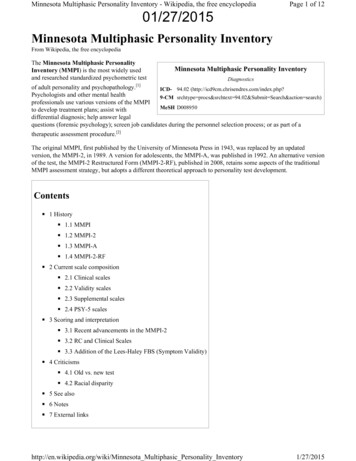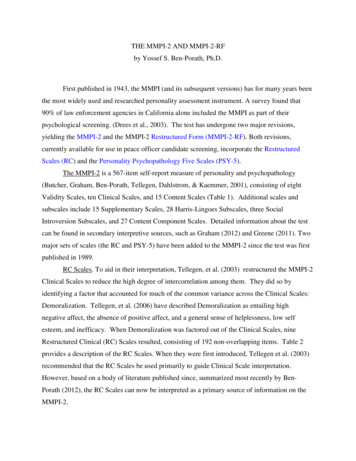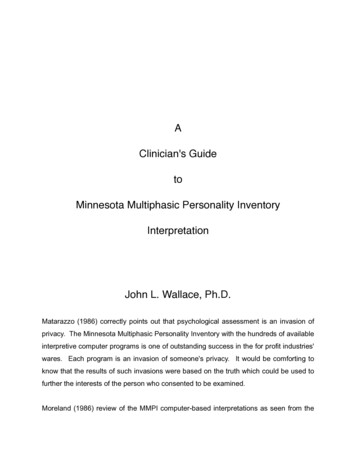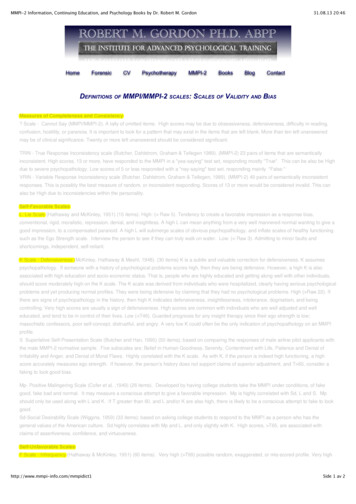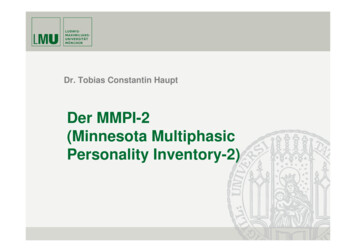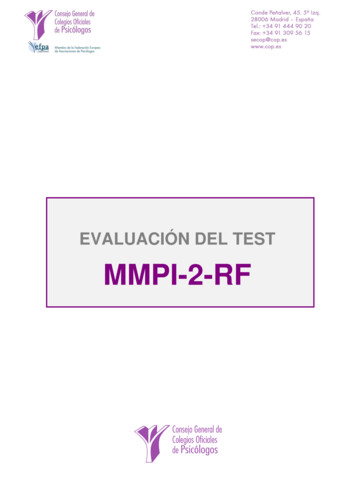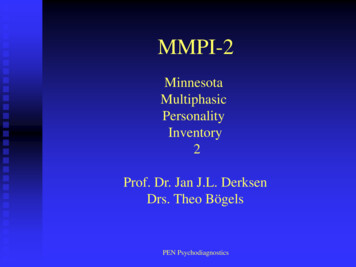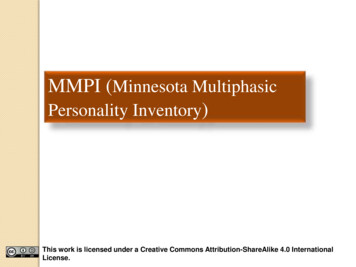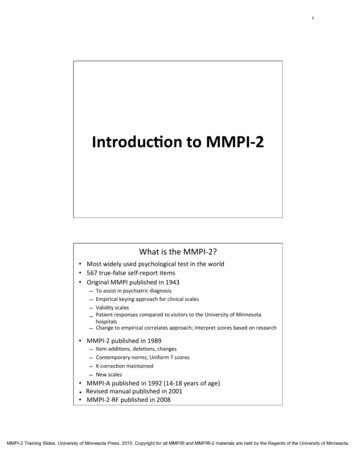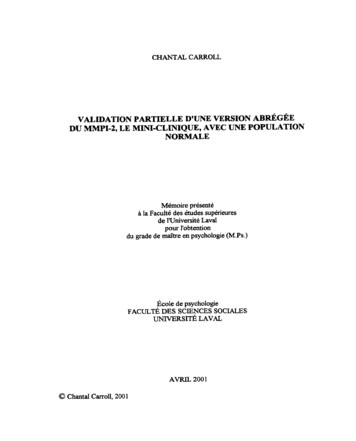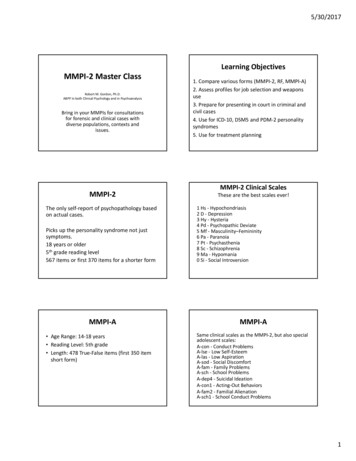
Transcription
5/30/2017Learning ObjectivesMMPI‐2 Master ClassRobert M. Gordon, Ph.D.ABPP in both Clinical Psychology and in PsychoanalysisBring in your MMPIs for consultationsfor forensic and clinical cases withdiverse populations, contexts andissues.MMPI‐2The only self‐report of psychopathology basedon actual cases.Picks up the personality syndrome not justsymptoms.18 years or older5th grade reading level567 items or first 370 items for a shorter formMMPI‐A Age Range: 14‐18 years Reading Level: 5th grade Length: 478 True‐False items (first 350 itemshort form)1. Compare various forms (MMPI‐2, RF, MMPI‐A)2. Assess profiles for job selection and weaponsuse3. Prepare for presenting in court in criminal andcivil cases4. Use for ICD‐10, DSM5 and PDM‐2 personalitysyndromes5. Use for treatment planningMMPI‐2 Clinical ScalesThese are the best scales ever!1 Hs ‐ Hypochondriasis2 D ‐ Depression3 Hy ‐ Hysteria4 Pd ‐ Psychopathic Deviate5 Mf ‐ Masculinity–Femininity6 Pa ‐ Paranoia7 Pt ‐ Psychasthenia8 Sc ‐ Schizophrenia9 Ma ‐ Hypomania0 Si ‐ Social IntroversionMMPI‐ASame clinical scales as the MMPI‐2, but also specialadolescent scales:A‐con ‐ Conduct ProblemsA‐lse ‐ Low Self‐EsteemA‐las ‐ Low AspirationA‐sod ‐ Social DiscomfortA‐fam ‐ Family ProblemsA‐sch ‐ School ProblemsA‐dep4 ‐ Suicidal IdeationA‐con1 ‐ Acting‐Out BehaviorsA‐fam2 ‐ Familial AlienationA‐sch1 ‐ School Conduct Problems1
5/30/2017MMPI‐ABig Problem:Norms underestimate psychopathologyT60 is now considered significantRestructured Clinical (RC) ScalesWhat happens when you make scales distinct andinternally consistent? Less sensitive topsychopathology, no personality syndromes.RCd dem DemoralizationRC1 som Somatic ComplaintsRC2 lpeLow Positive EmotionsRC3 cynCynicismRC4 asbAntisocial BehaviorRC6 perIdeas of PersecutionRC7 dneDysfunctional Negative EmotionsRC8 abxAberrant ExperiencesRC9 hpm Hypomanic ActivationThe MMPIand the Case of HysteriaDahlstrom, Welsh, and Dahlstrom (1972) said of the items inthe Hysteria scale, “Many of seem mutually contradictory.”The Hysteria scale has such seemingly unrelated issues suchas:somatic complaints,naiveté,denial of aggressive motives,unhappy home lifeand sexual conflicts.Scale 3- Hysteria is composed of statistically unrelated itemssuch as: “I feel weak all over much of the time. True.” (conversion). “I can be friendly with people who do things which I consider wrong.True.” (naively trusting to unconsciously repeat the victim role). “At times I feel like swearing. False.” (denial of aggressive motives). “I believe that my home life is as pleasant as that of most people I know.False.” (traumatic intimacy). “I am worried about sexual matters. True.” (conflict over sexuality). “Most of the time I feel blue. True.” (affective regulation). “I find it hard to make talk when I meet new people. False.” (seductivenessand need for attention).(Gordon, R.M. (2006c) False Assumptions About Psychopathology, Hysteria and the MMPI‐2 Restructured Clinical Scales. Psychological Reports, 98, 870‐872.)MMPI‐2 Depression Subtle‐ Aggression GuiltFalse Assumptions about Psychopathology“Gordon (2006) indicated that the RC Scales are based on falseassumptions about psychopathology (i.e. that consistent items areneeded to assess all psychopathologies), pointing to complexdiagnostic conditions like Hysteria, Post Traumatic Stress Disorder,and Borderline Personality Disorder that are better understood witha psychodynamic formulation recognizing internal conflicts andcontradictions. He indicates that a simplistic behavioral approachwith an insistence on more internally consistent and distinct scalesdoes not produce more external validity or useful measures formany of the complex disorders found in clinical practice." (Butcherand Williams, 2009, p.13)Many subtle items involve the denial of symptoms. At the normal level, suchdenials are an actual reflection of health. That same item in a person at theneurotic or borderline level is a reflection of defensiveness, a common aspectof psychopathology.A normal person might state, “At times I feel like smashing things. False.”This is a subtle item in the Depression Scale. In the context of a person who isclinically depressed, it assesses the denial of aggressive motives.Psychoanalytic theory states that depression can be due to the turning of theaggression inwards. A person may have forbidden wishes of aggressiontowards a parent, who one may also wish to protect or fears. The aggressivewish is then denied and turned inward as depression.Depression-Subtle items correlate negatively to Wiggins Manifest Hostility scaleButcher, J.N. and Williams, C.L. (2009), Personality Assessment with the MMPI-2:Historical Roots, InternationalAdaptations, and Current Challenges, Applied Psychology: Health And Well-Being, 1 (1), 105–135.(-.62), and positively with Lie (.50) and K (.48).Gordon, R.M. (2006) False Assumptions about Psychopathology, Hysteria and the MMPI-2 Restructured ClinicalScales. Psychological Reports, 98, 870-872.2
5/30/2017Paranoia Subtle- Splitting and ProjectionGordon, R.M. and Stoffey, R.W. and Perkins, B.L. (2013) Comparing the Sensitivity of theMMPI‐2 Clinical Scales and the MMPI‐RC Scales to Clients Rated as Psychotic, Borderline orNeurotic on the Psychodiagnostic Chart, Psychology: Special issue on Criminal InvestigativePsychology, 4, 9A, 12‐16.An obvious item from the Paranoia Scale is:“I believe I am being plotted against. True” (persecutory ideation).A subtle item from the Paranoia Scale is:“I think most people would lie to get ahead. False.” (naively trusting).People with paranoia project the split within their own personalities onto others.The damaged self is projected onto a devalued group, and the grandioseself is projected on to an idealized group.Ninety‐eight clients from forensic, disability and psychotherapyevaluations were evaluated on the MMPI‐2 and RC scales and rated forpersonality organization (neurotic, borderline or psychotic) on thePsychodiagnostic Chart.The results over‐all showed support that most of the MMPI‐2 scaleshave much more clinical sensitivity than the RC scales at all levels ofpsychopathology and particularly at the less pathological levels.K correction does not account for the elevation differences. Most ofthe RC scales add little to no incremental validity to the MMPI‐2Clinical scales except for RC1, RC2, and RC9 and these may be used assupplemental scales. Table 2The MMPI‐2 vs. RC Sensitivity Borderline Level of the Overall Personality OrganizationScales Mean SDtpdHs58.86 13.36 1.34 .185 .19RC1 57.63 13.98From: "James N. Butcher" butch001@umn.eduDate: January 23, 2008 12:34:20 PM ESTTo: rmgordonphd@rcn.comSubject: paperDRC266.57 16.01 3.43 .001 .4861.94 15.91HyRC364.31 13.98 5.23 .001 .7350.24 10.13PdRC466.06 11.20 7.15 .001 1.0054.04 10.13PaRC663.33 11.71 5.60 .001 .7853.94 11.90Hi BobI enjoyed your article on the RC scales a while back. Ithought that you might like to see this one.they certainlyare hyping a flawed set of scales.cheers Jim--PtRC763.67 12.98 7.69 .001 1.0850.86 10.98Dr. James N. Butcher Professor Emeritus Department of Psychology Universityof Minnesota Mpls. MN55455ScRC862.08 12.39 6.02 .001 .8452.86 11.78Ma 50.63 8.57 1.21 .234 .17RC9 49.35 8.31Gordon, R.M. and Stoffey, R.W. and Perkins, B.L. (2013) Comparing the Sensitivity of the MMPI‐2 Clinical Scales and the MMPI‐RCScales to Clients Rated as Psychotic, Borderline or Neurotic on the Psychodiagnostic Chart, Psychology: Special issue on CriminalInvestigative Psychology, 4, 9A, 12‐16.Assessing profiles for job selection andweapons useFor jobs requiring higher functioning such aspolice, your standards should be higher than foran armed guard.You are not screening out any psychologicalproblems.You are screening out individuals with poorjudgment, poor reality testing, addictions,impulse and anger problems.Organic, Somatizing, malingering, orsecondary gain? Review medical records and history!Conscious and Unconscious MotivationsHypochondriasisHysteriaHEA ‐ Health ConcernsHealth Concerns SubscalesHEA1 ‐ Gastrointestinal SymptomsHEA2 ‐ Neurological SymptomsHEA3 ‐ General Health Concerns3
5/30/2017Acting Out, DangerousnessActing Out, Dangerousness4 Pd ‐ Psychopathic Deviate: Pd‐O, Pd3 ‐ SocialImperturbability, Pd4 ‐ Social Alienation, Pd5 ‐ Self‐Alienation(Not: Pd‐S, Pd1 ‐ Familial Discord or Pd2 ‐ Authority Problems)RC4 ‐ asb ‐ Antisocial BehaviorRC9 ‐ hpm ‐ Hypomanic ActivationANG – Anger‐ ANG1 ‐ Explosive BehaviorASP ‐ Antisocial PracticesPersonality Psychopathology Five Scales (PSY‐5)AGGR ‐ AggressivenessPSYC ‐ PsychoticismDISC – DisconstraintHo ‐ Hostility6 Pa – Paranoia: Pa‐O, Pa18 Sc – Schizophrenia: Sc5 Lack of Ego Mastery,Defective Inhibition9 Ma – Hypomania: Ma‐OMMPI‐2 Mania scale and Psychopathic deviate scale are bestpredictors of acting out. Schizophrenia and Paranoiascales make criminality more irrational. On June 9, 2008, Travis Alexander's body was discoveredby his friends in a shower at his home. Alexander hadsustained 27 to 29 stab wounds, his throat had been slit,and he had suffered a gunshot wound to the head. Jodi Arias gave several different accounts about herinvolvement in Alexander's death. She originally toldpolice that she had not been in Mesa on the day of themurder and claimed that she last saw Alexander in April2008. Arias later told police that two intruders had brokeninto Alexander's home, murdering him and attacking her.Two years after her arrest, Arias told police that she killedAlexander in self‐defense, claiming that she had been avictim of domestic violence.21The prosecution argued that since a .25 caliber roundwas found near Alexander's body and a week beforea gun of the same caliber disappeared during aburglary of the Yreka home where Arias lived with hergrandparents, Arias had staged the burglary and usedthe gun to kill Alexander. Martinez claimed Arias hadstalked Alexander and had slashed his tires twice. Inaddition, in the final days before his death Alexanderhad called her a "sociopath" and "the worst thingthat ever happened to me", and was afraid of her.22 Clinical psychologist Janeen DeMarte testified for the prosecutionthat Arias did not suffer from PTSD or amnesia, and that she foundno evidence Alexander had abused Arias. Instead, DeMarte saidArias suffered from borderline personality disorder. Arias was found guilty of first‐degree murder. MMPI‐2 computer output (administered by the prosecutionpsychologist, DeMarte) showed significant elevations in: Psychopathic Deviate T110 (normal scores are T40‐T60) Paranoia T100 Schizophrenia T9023244
5/30/2017Use for ICD‐10, DSM5 and PDM‐2personality syndromesUse for ICD‐10, DSM5 and PDM‐2 personality syndromesGordon, R.M. (2017). Personality Disorders and Syndromes Across ICD‐10, DSM5, and PDM2. Currents, 1, pp. 10.Use the MMPI‐2 scales to inform you of aperson’s personality style.Treatment Indications Insight/Uncovering: Low in: Lie, Pd‐O, Ma, TRT ‐ NegativeTreatment Indicators High in: Ego Strength D and Pt Pd, Ma Supportive/Educative: High in Hs, Sc, Ma (psychotic to borderlinelevel personality organization)For more:www.mmpi‐info.comThank you!5
MMPI‐A Age Range: 14‐18 years Reading Level: 5th grade Length: 478 True ‐False items (first 350 item short form) MMPI‐A Same clinical scales as the MMPI‐2, but also special adolescent scales: A‐con ‐Conduct Problems A‐lse ‐Low S
